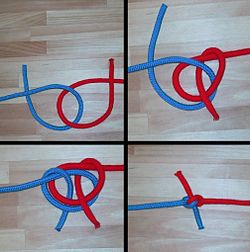| (2 intermediate revisions by the same user not shown) | |||
| Line 1: | Line 1: | ||
[[Image:Hunters Bend HowTo.jpg|right|thumb|200px|hunter's bend step by step]] | [[Image:Hunters Bend HowTo.jpg|right|thumb|200px|hunter's bend step by step]] | ||
| − | '''Hunter's bend''', also known as '''rigger's [[Bend knot|bend]]''' is a knot used to join two lines. It consists of 2 interlocking [[overhand knot]]s. The [[knot]] can jam under even moderate strain. It is almost identical to the | + | '''Hunter's bend''', also known as '''rigger's [[Bend knot|bend]]''' is a knot used to join two lines. It consists of 2 interlocking [[overhand knot]]s. The [[knot]] can jam under even moderate strain. It is almost identical to the [[Zeppelin bend]] (or '''Rosendahl''' bend) who's particular usefulness lies in its permanent 'open-ness', ie. it does not tighten up on itself under load so can still be immediately and easily undone. |
| − | |||
| − | |||
| − | |||
| + | Hunter's bend is one of the most recent knots to be discovered. It appeared on the front page of the London Times in 1978 and was credited to Dr. Edward Hunter. Dr. Hunter used it for years to tie broken shoelaces before discovering its originality through a friend in the 1970s. When it appeared on the front page, it led to much publicity for the knot and also to the foundation of the International Guild of Knot Tyers. | ||
{{knot-stub}} | {{knot-stub}} | ||
[[Category:Knots]] | [[Category:Knots]] | ||
Revision as of 01:16, 1 August 2006
Hunter's bend, also known as rigger's bend is a knot used to join two lines. It consists of 2 interlocking overhand knots. The knot can jam under even moderate strain. It is almost identical to the Zeppelin bend (or Rosendahl bend) who's particular usefulness lies in its permanent 'open-ness', ie. it does not tighten up on itself under load so can still be immediately and easily undone.
Hunter's bend is one of the most recent knots to be discovered. It appeared on the front page of the London Times in 1978 and was credited to Dr. Edward Hunter. Dr. Hunter used it for years to tie broken shoelaces before discovering its originality through a friend in the 1970s. When it appeared on the front page, it led to much publicity for the knot and also to the foundation of the International Guild of Knot Tyers. Template:Knot-stub

